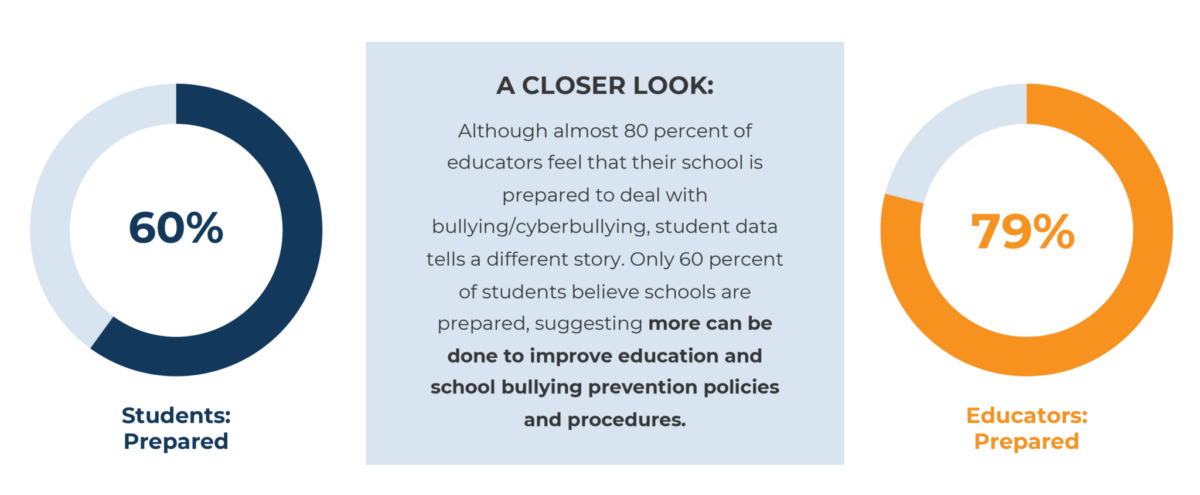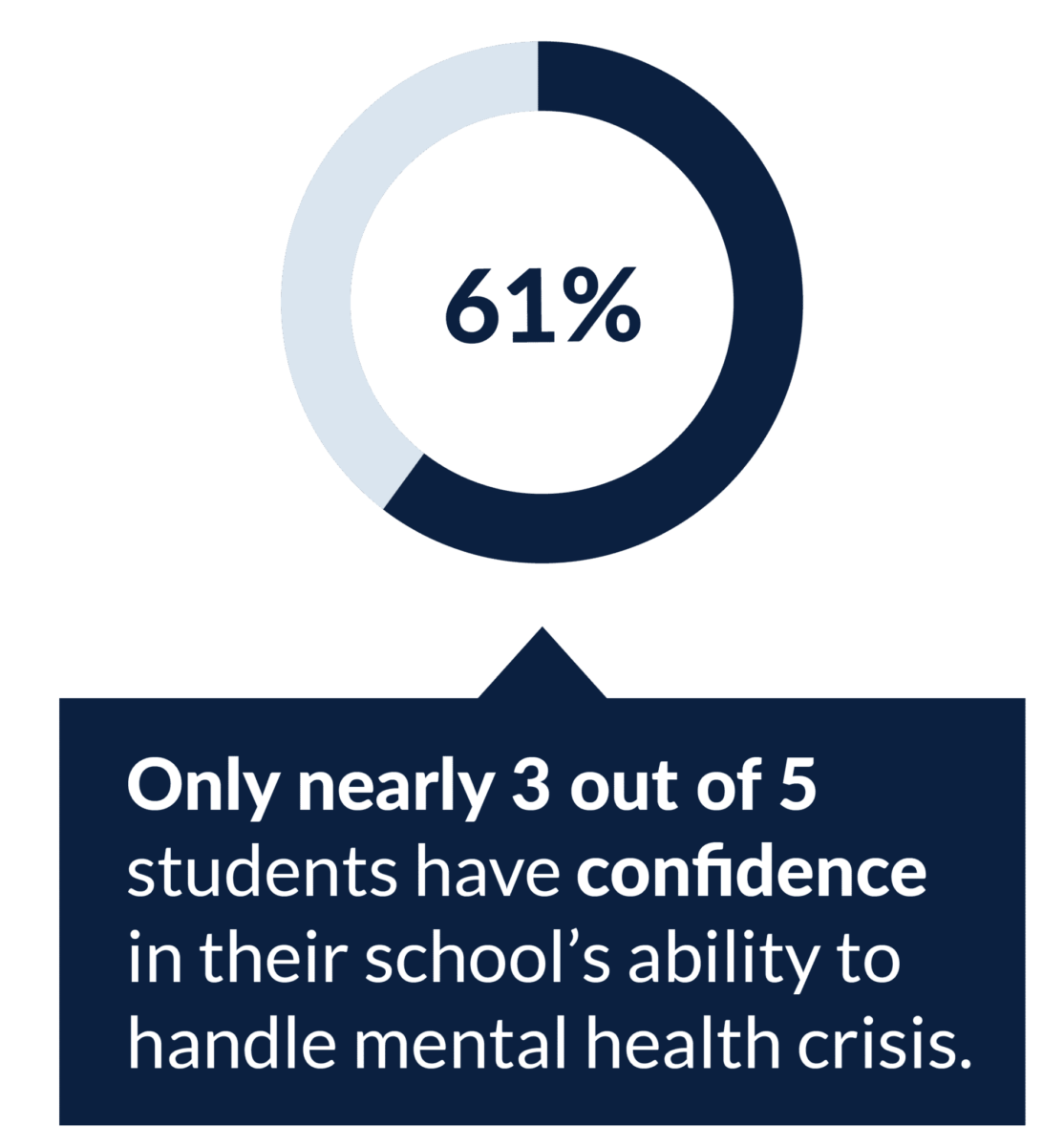Schools are meant to be safe havens for growth and learning. But it can be hard for students in K-12 to feel safe in the classroom and learn if they’re witnessing or experiencing bullying.
Despite decades of anti-bullying campaigns and education efforts in schools, the 2022 State of School Safety Report found strong concerns remain about peer-on-peer abuses (such as physical and verbal attacks) and various forms of bullying and harassment. While these issues remain front and center for many in and out of K-12, students, educators, parents, administrators, and staff aren’t all on the same page about the current state of bullying in school districts.
Understanding the disconnect can help address these issues. Learn what adult stakeholders need to know to help stop and prevent bullying and cyberbullying in K-12 schools.
How ready are schools to handle bullying?
The report, by Safe and Sound Schools and co-sponsored by Lightspeed Systems®, found there’s a divide between the perceptions of students and teachers when it comes to bullying: Nearly 80% of educators polled felt their school was ready to deal with bullying and cyberbullying, but only 60% of students agreed.

“That’s the power of asking,” said Michele Gay, Co-Founder of Safe and Sound Schools. “[Students are] speaking up, and they’re telling us, ‘What’s here isn’t enough.’”
To close the gap in preparedness perception, stronger anti-bullying policies need to be in place for ensuring better preparation for bullying and cyberbullying. When it comes to bullying, both online and offline, Gay shared that oftentimes, schools only see “the tip of the iceberg,” and educators often don’t learn that a bullying incident has occurred until the situation has already escalated.
Edtech solutions can help educators get the visibility they need so they can intervene sooner, correct the behavior, and even prevent bullying and cyberbullying before it starts or escalates. Online safety software, like Lightspeed Systems, can help K-12 schools address bullying by:
- Detecting signs of cyberbullying with AI to flag and alert safety staff to instances of students using inappropriate language and terms related to cyberbullying.
- Preventing harmful behavior before it starts by allowing safe social media use with “read-only mode” to keep valuable content accessible to students without the risks.
- Ensuring YouTube is a safe, distraction-free learning resource by blocking potentially harmful videos, comments, and sidebars.
- Giving educators control over student screens to view their online activity and close any distracting tabs, allow and block URLs, and share screens during both in-person and remote learning.
In addition to utilizing AI-powered school safety software and a team of safety specialists to review flagged bullying and cyberbullying instances, K-12 districts need to keep the lines of communication between adults and students open, honest, and secure.
K-12 mental health concerns aren’t going away
Although most survey respondents from the 2022 State of School Safety Report were aware of at least one mental health support program at their school—an encouraging finding—not all students, teachers, or public safety officers knew what resources were available. Meanwhile, nearly all the survey respondents said that anxiety and depression were growing problems on campus and those issues can be made worse by bullying. To help address mental health, K-12 schools need to prevent bullying and cyberbullying.
Again, there was a divide in answers about mental health preparedness at schools, this time among all stakeholders surveyed. While 83% of teachers felt their school was ready to handle a mental health crisis, only 73% of public safety officers felt the same. More concerning, however, is only 66% of parents and 61% of students had confidence in their school’s ability to handle such a crisis.
This suggests there is an opportunity for greater communication at schools around mental health and likely a need for expanded services. Gay identified a significant gap between the number of school psychologists, counselors, and social workers and the increasing number of students in need of mental health support.
Compounded by the impact of the COVID-19 pandemic and nationwide shortages in the mental health field, these pressing issues will likely continue to challenge schools and communities for years to come. Therefore, it is critically important for schools to engage in long-term, strategic planning to build capacity, educational programming, and school- and community-based resources to support student mental health and wellness.

Create a safe school culture for everyone—on campus and online
A welcoming and inclusive environment is an important part of a healthy and safe school, one where bullying is infrequent and addressed swiftly.
While the 2022 State of School Safety Report found more than half of all groups surveyed agreed that their schools have a positive culture and climate, student respondents showed the lowest level of agreement with this statement. Feeling connected, welcomed, and safe in school is essential to student success and growth; therefore, is imperative that schools focus on fostering positive culture and climate as a foundational element to address bullying and school safety.
A crucial component of creating a positive school culture is supporting the people who work there—a school’s most valuable resource is its people. All survey respondents named SROs, nurses, mental health staff, and behavioral threat assessment teams as the first resources for keeping schools safe. But while 88% of teachers said that most students on campus had a trusted adult to confide in, only three-quarters of students said the same. This is why investing in these support roles, including training and education, is paramount.
Social-emotional learning (SEL) is another way to foster a supportive school environment. While nearly all educators responded that SEL was important to school safety, only 73% of students agreed, presenting another opportunity for additional education for students.
Of the groups surveyed in the report, students reported the lowest confidence that their concerns about school safety would be taken seriously. School districts should make their students an active part of safety and anti-bullying measures and make sure that adult stakeholders incorporate student feedback quickly and in good faith.
Overall, both school staff and parents should engage with students often to help build their confidence. Teaching digital citizenship and incorporating it into the school curriculum is an important first step to ensuring students understand the impact of their actions online and can help support a more enriched anti-bullying culture.
Download this free guide to help identify and prevent bullying in your school district.
Tactics to Stop Bullying & Cyberbullying in K-12 Schools: Free Downloadable Guide

